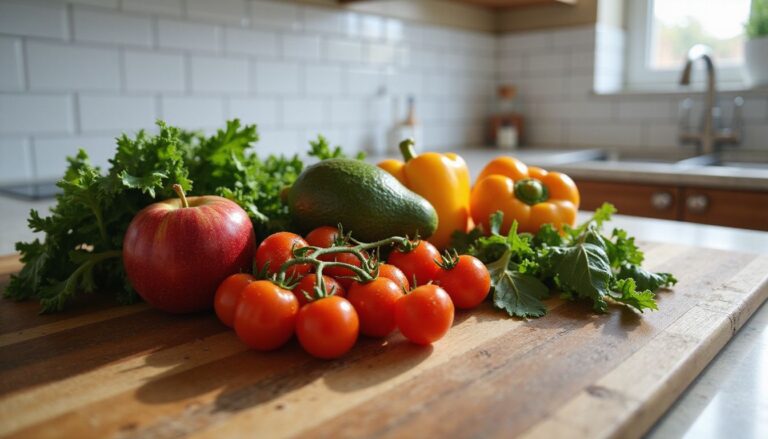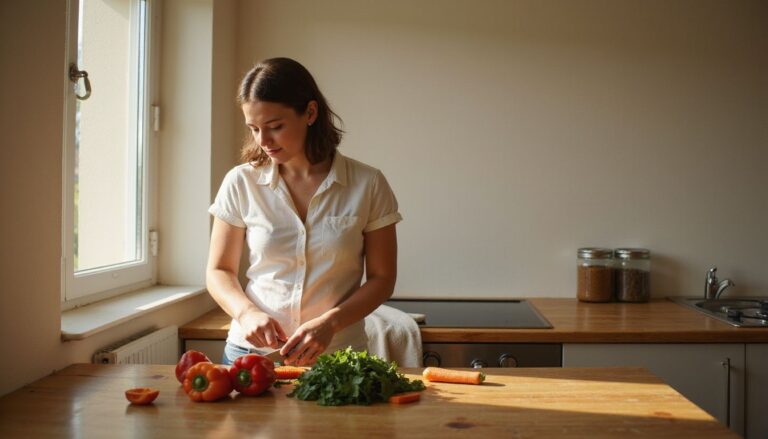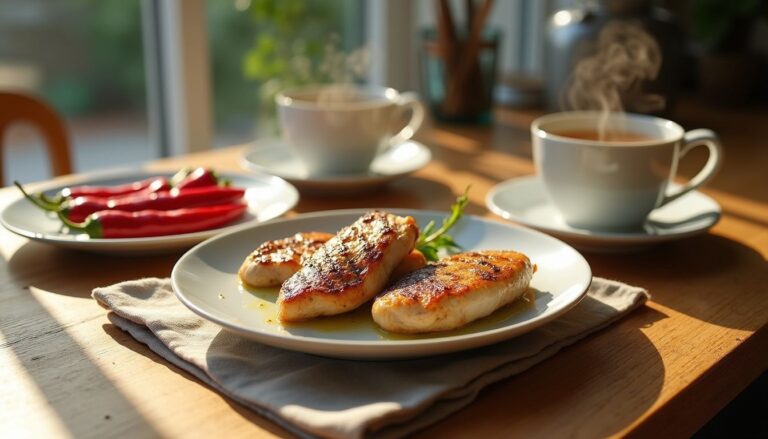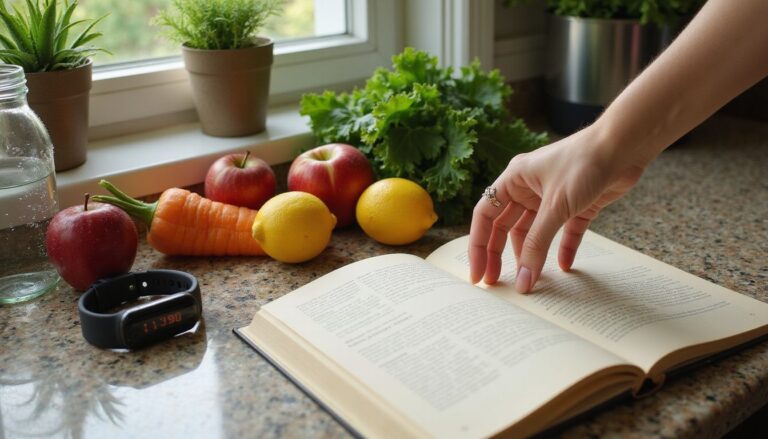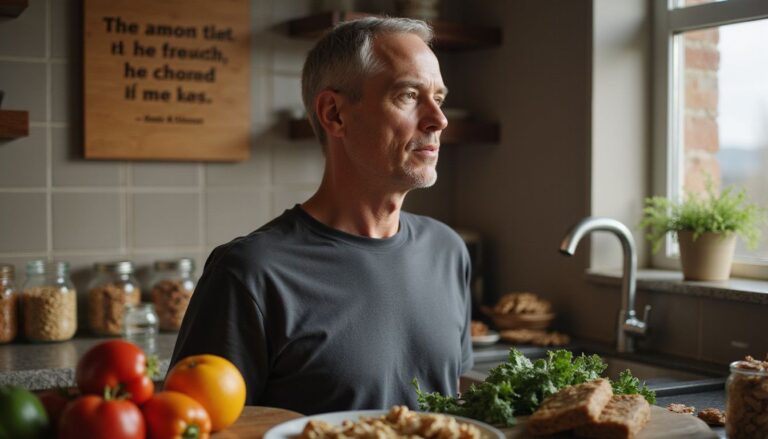Top Low Calorie Foods For Weight Loss: Your Ultimate Guide
Our Nutrition Assistant AI Suite will transform your body. You will lose fat, get toned, and build muscle. Gain confidence and optimal health.
Hungry while trying to lose weight? You are not alone. Low-calorie foods help you eat fewer calories and still feel satisfied, thanks to water and fiber that add volume.
In this guide, you will learn how to choose foods that keep you feeling full longer. You will see how to build a healthy eating plan that supports calorie goals without feeling deprived. Use these ideas to refresh your daily meals and snacks.
Key Takeaways
- Choose low-calorie foods high in water or fiber, like apples at 62 calories per cup and watermelon at 46 calories per cup, to control hunger with fewer calories.
- Swap calorie-dense snacks for fruit, vegetables, air-popped popcorn at 30 calories per cup, and non-fat Greek yogurt to support weight loss and nutrition.
- Lean proteins, such as chicken breast at 120 calories per 3 ounces and tofu at 76 calories per 100 grams, help you stay full and protect muscle.
- Build variety with leafy greens, cruciferous vegetables, whole grains like oatmeal at 75 calories per half-cup cooked, and several protein options to prevent diet boredom.
- Evidence from USDA data and the Dietary Guidelines for Americans 2020-2025 supports high-volume, low-energy-density foods for healthy, steady weight management.
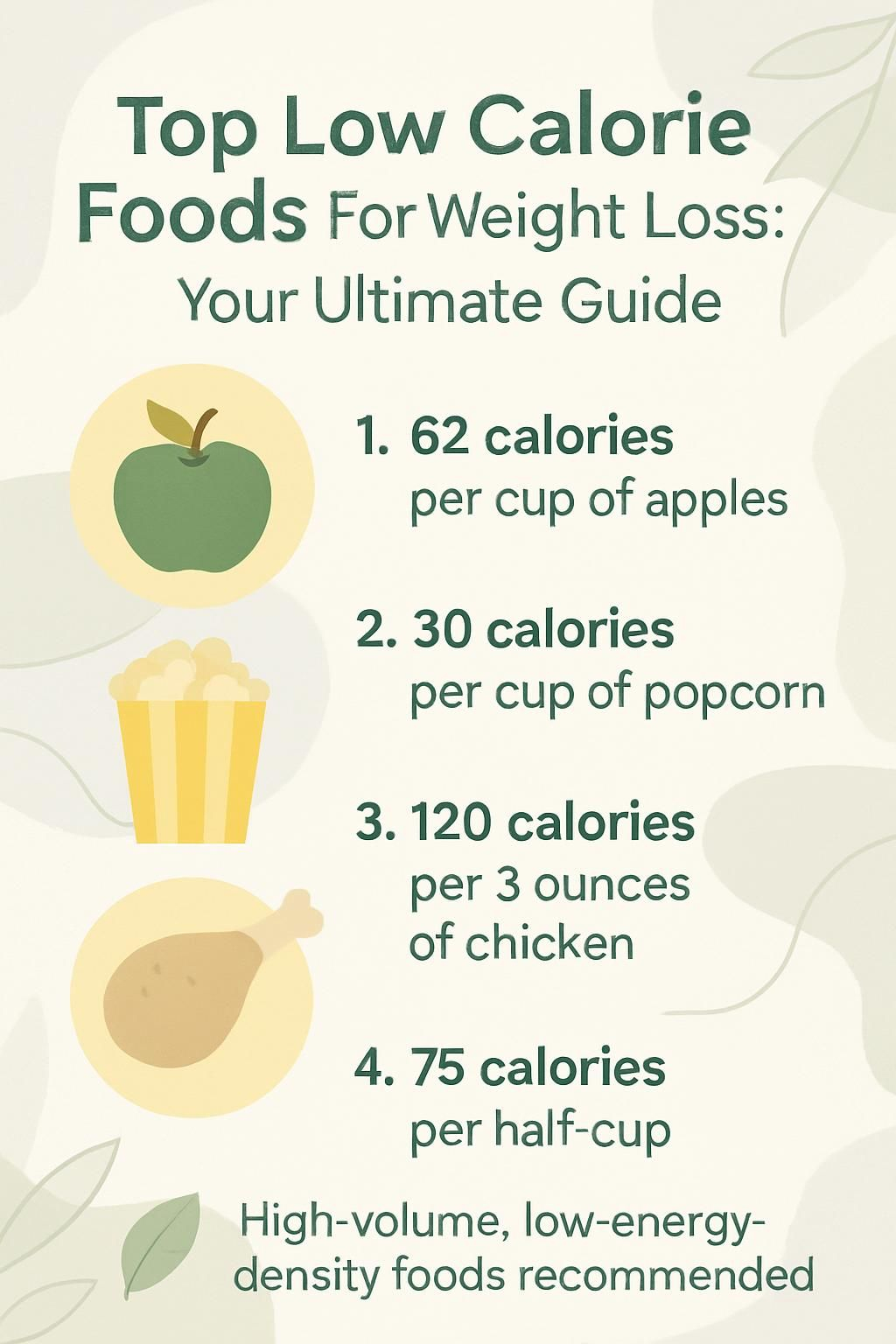
Understanding Low-Calorie Foods

Low-calorie foods give you fewer calories per serving and make room for larger portions. Energy density, which is calories per gram of food, explains why some foods are filling while others are not.
What are low-calorie foods?
Low-calorie foods provide fewer calories per serving, so you can eat more food for the same energy. One cup of grapes has about 104 calories, but one cup of raisins has about 480 calories because the water has been removed.
Fruits and vegetables give good volume for few calories. A small apple has about 80 calories. One cup, 109 grams, of sliced apples with skin has only 62 calories. Leafy greens are even lighter. One cup, 36 grams, of chard has just 7 calories, and cabbage has about 22 calories per cup, 89 grams.
Water-rich produce boosts fullness. A cup of diced watermelon, 154 grams, has about 46 calories, so it adds bulk without a lot of calories.
“Eating lower calorie foods lets you fill up on more food but take in fewer total calories.”
How does energy density affect weight loss?
Energy density is the number of calories in a given weight of food. High energy density foods like French fries pack many calories into a small portion. A small order of fries is roughly 250 calories. For the same calories, you could eat a large salad built from spinach, strawberries, and a small apple.
Water, fiber, and fat drive energy density. Water-rich foods like grapefruit or carrots add volume with fewer calories. Half a grapefruit is about 90 percent water with 64 calories. A medium carrot is about 88 percent water with 25 calories.
Fiber also lowers energy density and helps you stay full. One cup of air-popped popcorn has about 30 calories, yet it takes space and slows digestion compared with chips or candy. During a busy season, I switched to low-fat yogurt with berries for afternoon snacks. I noticed fewer cravings and steadier energy.
Benefits of Incorporating Low-Calorie Foods in Your Diet
Low-calorie foods help you eat less while still getting vitamins and minerals. These choices support a healthy diet and can improve health markers over time.
How do low-calorie foods reduce overall calorie intake?
Swapping high-calorie foods for lower calorie options trims daily intake fast. Choose an apple instead of a donut and you save hundreds of calories while still feeling satisfied.
Fruits, vegetables, and whole grains tend to have low energy density. You eat more by volume and take in fewer calories. Fiber-rich foods like broccoli and whole grains improve fullness, which makes cutting calories easier over the day [1]. I often keep oranges or air-popped popcorn on hand for this reason.
[1] Dietary Guidelines for Americans 2020-2025: https://www.dietaryguidelines.gov/
Can low-calorie foods help keep you feeling full longer?
Yes. Foods high in fiber, such as whole grains and many fruits, digest slowly and help you stay full. One cup of air-popped popcorn has only about 30 calories but offers bulk that eases hunger.
Produce with high water content increases meal size without many calories. Leafy salads with tomatoes or cucumbers can help you reach fullness sooner. Whole fruit is usually more filling than juice because the fiber remains. Oatmeal and other whole grain cereals have slow-digesting carbs that steady appetite through the morning.
How do low-calorie foods support a balanced, nutritious diet?
Many low-calorie foods are nutrient-dense, meaning they supply vitamins and minerals for few calories. Citrus, apples, watermelon, and berries deliver vitamin C and other nutrients. Leafy greens and cruciferous vegetables offer vitamin A, vitamin C, vitamin K, beta-carotene, manganese, calcium, and fiber.
Pair plenty of vegetables and fruit with lean protein and whole grains. Eggs, lean chicken breast, cod or salmon, tofu, beans, and non-fat Greek yogurt provide protein without much saturated fat or added sugar. Seeds and nuts add healthy fats, but keep portions small because they are calorie-dense. Limiting sweets and rich pastries cuts empty calories that can raise the risk of obesity and diabetes.
Top Low-Calorie Foods for Weight Loss
Build your plate with low-calorie foods that also bring protein, fiber, and flavor. These picks help you feel full and support steady progress.
Fruits
Apples, strawberries, oranges, and watermelon offer volume with few calories. One cup, 109 grams, of sliced apples with skin has about 62 calories. A cup, 166 grams, of strawberries has about 53 calories and brings helpful antioxidants. Watermelon is mostly water and has about 46 calories per cup, 154 grams.
One medium orange has about 62 calories. A small clementine has about 35 calories. Berries supply fiber that supports fullness without much sugar or sodium. Many people enjoy fruit with non-fat Greek yogurt for a snack that adds protein and calcium.
Why are apples good for weight loss?
Apples are easy to carry, low in calories, and rich in fiber. One cup with skin has about 62 calories and roughly 3 grams of fiber. Fiber supports fullness and helps you eat fewer calories at later meals. Apples also supply vitamin C and other compounds that support health.
What are the best berries for weight loss?
Strawberries, blueberries, and raspberries are great choices. One cup of strawberries, 166 grams, contains about 53 calories and a good dose of vitamin C. Research suggests berry intake may support brain health over time.
Berries are high in fiber and antioxidants. This mix helps with fullness and replaces high-calorie snacks like candy or cheese crackers. Try blueberries or raspberries with non-fat Greek yogurt for a quick, high-protein snack.
Is watermelon a good low-calorie fruit?
Yes. Watermelon is about 92 percent water, so it adds volume for very few calories. One cup of diced watermelon has about 46 calories. It also provides vitamin C and hydration. Enjoy it chilled as a snack or add cubes to salads and smoothies.
How do oranges help with weight loss?
Oranges and clementines are portable, juicy, and low in calories. A clementine has around 35 calories and supplies roughly 40 percent of the daily value for vitamin C. The water and fiber help with fullness, which can reduce later snacking. Vitamin C supports immune function as part of a balanced diet.
Vegetables
Vegetables offer very low calorie counts with high volume and key nutrients. Leafy greens like spinach, chard, and kale are extremely light. One cup of raw spinach or chard has about 7 calories, yet both help fill the plate.
Cruciferous vegetables, including broccoli, Brussels sprouts, cabbage, and cauliflower, provide fiber, vitamin C, and other nutrients. A cup of chopped raw broccoli has about 31 calories and over two grams of protein. Roots like carrots, turnips, rutabagas, and beets bring natural sweetness with modest calories per serving.
Water-rich vegetables such as red bell peppers, cucumbers, celery, and cherry tomatoes add crunch and hydration with very few calories. Use them to bulk up meals and keep calorie totals in check.
Which leafy greens are best for weight loss?
Leafy greens are high in nutrients yet low in calories. A cup of chard has about 7 calories and plenty of vitamin K. One cup of raw spinach also has about 7 calories plus provitamin A and folate.
Cooked kale offers a bit more energy, about 49 calories per cup, and delivers more than the daily value for vitamins C and K. Mix greens into pasta, sandwiches, omelets, and wraps. Low energy density helps you feel full while keeping calorie intake lower.
What are cruciferous vegetables and why are they good for weight loss?
Cruciferous vegetables include broccoli, Brussels sprouts, cabbage, and cauliflower. One cup of cooked broccoli has about 54 calories. One cup of cooked Brussels sprouts has around 70 calories. Cabbage has about 22 calories per cup, and cauliflower has about 40 calories per cup.
These vegetables supply fiber and helpful plant compounds. They add hydration and volume and support a balanced diet. Research links higher intake of cruciferous vegetables with better long-term health outcomes.
Are root vegetables good low-calorie options?
Yes. Many root vegetables are low in calories and bring useful nutrients. One medium carrot has about 25 calories. A cup of cooked turnips has about 34 calories. A cup of rutabaga has about 51 calories. A cup of cooked beets has about 74 calories and supplies folate and manganese.
Roasted roots make easy sides that boost plate volume without adding much fat. They also bring fiber that helps manage hunger.
What water-rich vegetables support weight loss?
Celery, cucumbers, red bell peppers, and cherry tomatoes are top picks. One cup of celery has about 17 calories. Half a cup of cucumbers has about 8 calories. A cup of sliced red bell pepper has about 24 calories and is rich in vitamin C and lycopene. A cup of cherry tomatoes has about 27 calories and also provides lycopene.
These vegetables add crunch and moisture and help you feel full with fewer calories.
Proteins
Higher protein foods improve fullness and support muscle while you are in a calorie deficit. Lean chicken breast provides about 31 grams of protein per 100 grams for about 165 calories. White fish such as cod and tilapia offer similar benefits.
Eggs fit most eating patterns. One large egg has about 70 calories and 6 grams of protein. Tofu, a soy product, supplies about 8 grams of protein per 100 grams with roughly 76 calories. Cottage cheese, especially low-fat, gives high protein with moderate calories.
Why choose lean chicken breast for weight loss?
Lean chicken breast is rich in protein and low in fat. A 3-ounce portion has about 26 grams of protein and around 120 calories. Protein supports fullness, aids muscle maintenance, and fits well with salads, grain bowls, and vegetable stir-fries.
Which fish varieties are low-calorie and good for weight loss?
Salmon and tuna provide protein with reasonable calories. A 3-ounce cooked salmon portion has about 120 calories and contains omega-3 fats. Tuna has about 100 calories per 3 ounces and supplies vitamin D.
Other lean choices include cod, tilapia, pollock, and haddock. Many of these provide fewer than 90 calories per 3-ounce cooked portion. They help you meet protein goals without adding many calories.
How do eggs fit into a low-calorie diet?
Eggs are nutrient-dense and versatile. Egg whites have about 15 calories each and provide high-quality protein without fat. Whole eggs add vitamin D, B12, and choline, which supports many body functions. Studies suggest eggs at breakfast can reduce hunger later in the day compared with refined-grain breakfasts.
Is tofu a good protein for weight loss?
Tofu is a plant-based protein that is easy to season. Each 100 grams delivers about 8 grams of protein and around 76 calories. It works in stir-fries, salads, scrambles, and blended sauces.
Tofu helps reduce saturated fat intake if you are replacing higher fat meats. Its protein content supports fullness while keeping calories in check.
What makes cottage cheese a good low-calorie protein?
Low-fat cottage cheese is high in protein for moderate calories. One cup has about 160 calories and close to 28 grams of protein. The texture and protein help you stay full between meals. Pair it with berries or pineapple for a quick snack that delivers protein and micronutrients.
Snacks and Grains
Air-popped popcorn is light and filling. One cup has about 31 calories and brings fiber. Oatmeal is another smart choice. Half a cup of cooked oats has about 75 calories and steady energy from fiber.
Plain rice cakes usually have about 35 calories each. Non-fat Greek yogurt has about 90 to 100 calories per single-serve container and more than 15 grams of protein. Whole grains, such as oats and brown rice, offer more nutrients than many processed snacks.
Is air-popped popcorn a healthy low-calorie snack?
Yes. Air-popped popcorn is low in energy density and high in volume. One cup has roughly 30 calories. You can enjoy several cups and still keep calories low. The fiber and size help curb cravings for higher-calorie snacks.
How does oatmeal support weight loss?
Oatmeal is a whole grain that supports fullness. A cup of cooked oats has around 150 calories, about 4 grams of fiber, and about 5 grams of protein. Fiber slows digestion and steadies hunger. Prepare oats with water or milk and top with strawberries or blueberries for added nutrients without many extra calories. USDA FoodData Central provides these standard values.
Are rice cakes good low-calorie snack options?
Plain rice cakes are crunchy and low in calories, about 35 per cake. They help with portion control compared to chips or buttery crackers. Add sliced fruit, a thin layer of peanut butter, or non-fat Greek yogurt to boost flavor and nutrition.
Why choose non-fat Greek yogurt for weight loss?
Non-fat Greek yogurt is high in protein and low in fat. A typical 6-ounce container has about 90 to 100 calories and more than 15 grams of protein. It curbs hunger and supports muscle. Add oranges, berries, or a small sprinkle of nut granola for a balanced snack.
Tips for Including Low-Calorie Foods in Your Daily Diet
Small, steady changes add up. Use these simple steps to build meals that are filling, flavorful, and lower in calories.
How can you plan meals with high-volume, low-calorie foods?
Fill half your plate with high-water vegetables like cucumbers, zucchini, spinach, and salad greens. This adds bulk and fiber for very few calories. Use large vegetable portions at meals so you feel full and still meet calorie goals.
Pair calorie-dense foods, such as protein or whole grains, with low energy density choices. Mix broccoli or zucchini into rice. Stir chopped vegetables into cottage cheese or non-fat Greek yogurt. These pairings improve fullness, support heart health, and help keep total calories manageable.
What are ways to add variety to avoid diet monotony?
Rotate your produce, proteins, and grains so meals stay interesting and balanced. Changing textures and colors helps you enjoy low-calorie eating for the long term.
- Vegetables: Spinach or kale one day, broccoli or cauliflower the next. Add carrots, beets, and cucumbers for color and crunch.
- Fruits: Apples, berries, watermelon, and oranges across the week for different flavors and nutrients.
- Proteins: Chicken breast, salmon, tuna, eggs, tofu, and low-fat cottage cheese in a simple rotation.
- Grains: Oatmeal for breakfast, brown rice at dinner, and whole-wheat bread for a sandwich.
- Snacks: Air-popped popcorn on some days and non-fat Greek yogurt on others.
Here is a quick rotation example to spark ideas.
Summary Table: Food Rotation Examples
| Category | Options |
|---|---|
| Vegetables | Spinach, kale, broccoli, cauliflower, carrots, cucumbers |
| Fruits | Apples, strawberries, blueberries, watermelon, oranges |
| Proteins | Chicken breast, salmon, tofu, eggs, cottage cheese |
| Grains | Oatmeal, brown rice, whole-wheat bread |
| Snacks | Air-popped popcorn, non-fat Greek yogurt |
Which low-calorie spices and herbs enhance flavor?
Fresh herbs like basil, cilantro, parsley, and dill brighten meals for almost no calories. Spices such as black pepper, paprika, cumin, chili powder, turmeric, garlic powder, and onion powder add depth.
Splash lemon juice or vinegar on vegetables, fish, or beans for extra tang. Sprinkle oregano or rosemary on roasted carrots or air-popped popcorn for big flavor without added fat.
Why prepare snacks at home to control ingredients?
Homemade snacks give you control over calories, sugar, and fat. Many packaged snacks contain extra oils and sweeteners. Preparing air-popped popcorn, cut fruit, veggie sticks, or low-fat cottage cheese bowls keeps ingredients simple.
Measure portions into small containers so it is easy to grab and go. This habit helps you avoid higher-calorie choices during busy moments.
Sample Meal Ideas Featuring Low-Calorie Foods
Use these simple meal ideas to put low-calorie foods into action. Adjust portions to fit your calorie target.
What is a healthy low-calorie breakfast idea?
Cook oatmeal and top it with strawberries and chopped walnuts. One cup of strawberries has about 53 calories and adds natural sweetness. Or, mix non-fat Greek yogurt with mixed fruit and a small sprinkle of granola for a high-protein start.
How to make a weight loss-friendly lunch with low-calorie foods?
Build a salad with 1 cup of spinach, about 7 calories, and 1 cup of sliced red bell pepper, about 24 calories. Add tomatoes and cucumbers for extra volume.
Top with grilled chicken breast or tofu for protein. If you want crunch, add a small serving of whole-grain crackers on the side to keep calories controlled.
What is a nutritious low-calorie dinner option?
Pair a 3-ounce fillet of salmon or tuna with a cup of cooked broccoli and a cup of cauliflower. This dinner can land under 250 calories depending on cooking method. Add a small portion of quinoa or brown rice if you need more energy.
Round out the plate with sliced cucumbers or tomatoes for freshness. Many people find this balance filling without feeling heavy.
What are good low-calorie snack ideas?
Air-popped popcorn at about 30 calories per cup is a smart pick. Enjoy several cups for minimal calories and solid fullness.
Other ideas include rice cakes with apple slices, non-fat Greek yogurt with blueberries, or a clementine with a small piece of dark chocolate. Keep portions modest to stay within your daily goals.
The Role of Hydration in Weight Loss
Hydration supports appetite control and energy. Think of water and water-rich foods as quiet helpers that make healthy eating easier.
Why is water essential for weight loss?
Water can help you feel full before meals, which may reduce calorie intake. Foods with high water content, like cucumbers or watermelon, add volume without many calories.
Staying hydrated also supports normal metabolism and daily energy. Many people find that a glass of water before meals helps them choose portions that fit their plan.
Which foods have high water content to aid hydration?
Fruits such as watermelon, grapefruit, and oranges are rich in water and light in calories. One cup of watermelon, 154 grams, has about 46 calories. Half a grapefruit is roughly 90 percent water with about 64 calories.
Vegetables like cucumbers, celery, and carrots also add fluid. Half a cup of cucumbers has about 8 calories. One cup of celery has about 17 calories. A medium carrot is about 88 percent water and about 25 calories.
Conclusion
Choosing low-calorie foods helps you manage calories, feel full, and still get vitamins and minerals. Lean protein, fiber-rich grains, high-water fruits, leafy greens, and smart dairy choices make meals satisfying without a lot of calories.
Use variety to keep your eating plan enjoyable. If you have medical conditions, specific nutrition needs, or questions about weight, speak with a registered dietitian or your healthcare provider. This guide is for general education and is not a substitute for personal medical advice.
FAQs
1. What are the top low calorie foods that can help with weight loss and improve your overall health?
Low calorie foods such as leafy greens, cucumbers, tomatoes, berries, and white fish support weight loss while providing essential nutrients to improve your overall health.
2. How do low calorie foods contribute to better health during a weight loss plan?
Eating low calorie foods helps reduce total energy intake; this supports fat loss and improves your overall health by supplying vitamins, minerals, and fiber without excess calories.
3. Are there scientific studies supporting the benefits of eating low calorie foods for weight management?
Research shows that diets rich in vegetables and fruits with fewer calories promote healthy body composition; these choices also lower risks linked to chronic diseases while improving your overall health.
4. Can you share a personal example of using low calorie foods for effective weight control?
After adding more salads made from spinach, bell peppers, and grilled chicken into my meals each week, I noticed steady progress toward my goals along with improved energy levels which helped me improve my overall health.


